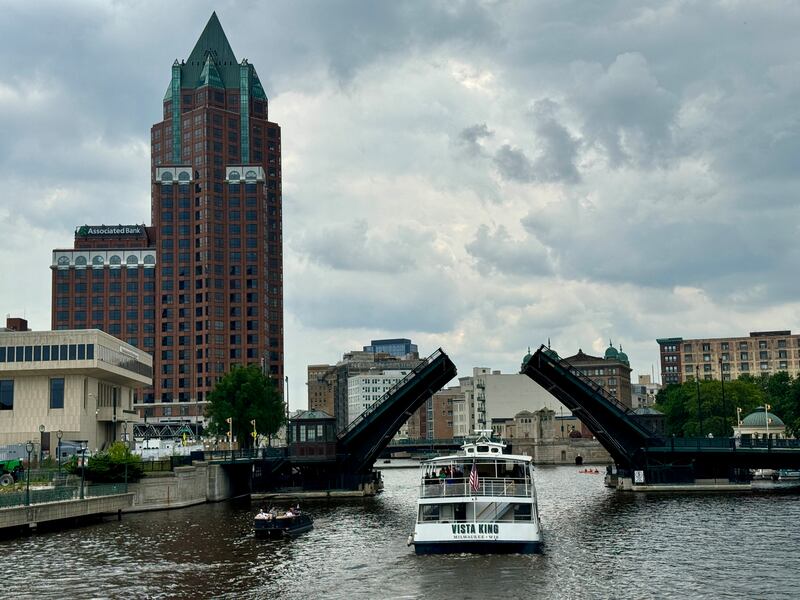On the bridge close to the Usinger’s Famous Sausage building, there’s a megaphone row taking place. On one side of the bridge is a lone guy in his twenties proclaiming gay rights. Directly across from him, on the other side of the bridge is a man yelling back anti-gay obscenities. He has a gun in his holster. It’s legal to open-carry in Milwaukee. “But nobody does it,” says a bystander who is from the city. “It’s just weird, isn’t it?”
It’s unclear whether this showdown was arranged or whether the two men just happened to be carrying megaphones. The exchange of viewpoints is spicy but as it happens, the gay-rights activist has a stand-up comic’s timing and is parodying the scene even as he stars in it. When a group of cycling officers passes by, he mock-shouts: “Help me, officers. He’s offending me by shouting at me,” catching the attention of two chunky Republican convention goers who are crossing the bridge eager to display their good-ole-boy credentials. “Pussy,” one of them shouts.
Around the corner, another culture clash is taking place where a young Milwaukee man in a Covid mask and the 1990s skateboard regalia favoured by a lot of young locals is confronting an older performative champion of Republicanism who is dressed as Uncle Sam and sings patriotic songs. The Milwaukeean is telling him he has blood on his hands, that he’s wearing the uniform of old genocides and to get the f*** out his town.
It was always going to be a source of tension: the arrival of a Republican convention defined by the resurgent Maga dynamic in one of the most steadfastly Democratic cities of the Rust Belt. You don’t have to spend long in downtown Milwaukee to get a sense of what the place was and what it could become.
READ MORE
The short grid of streets around the river in the heart of downtown contain a stunning exhibition of the handsome, late-1800s buildings when the city was, like the rest of the growing urban centres around Lake Michigan, on an unstoppable upsurge.

In the first half of the 1900s, the city became buoyant on the ceaseless production and expansion of American Motors, Schiltz Brewery, Pabst Brewery, Allis-Chalmers, Briggs and Stratton, and AO Smith. The breweries opened art-deco pubs to celebrate particular beers. Pabst provided a gorgeous theatre for the city, which still stands.
Demand for jobs led to a huge influx from the southern states by the black community, which went from 8,821 in 1940 to 105,000 in 1970, with the predictable racial tensions and stand-offs of the 1960s.
After 1970, the vast majority of those manufacturing jobs disappeared, leaving a hollowed-out and ghettoised community on the north side of the Milwaukee, where the recovery is an ongoing project.
Ironically, during that downturn, the city was chosen as the notional location for Happy Days, the sitcom that looked back from the turbulent 1970s at an idealised vision of the 1950s through the adventures of the Cunningham family and their friend, the Greaser Arthur “Fonzie” Fonzarelli. The show’s chief selling point was the performance of Henry Winkler in the lead, and his role was marked by the unveiling on the Milwaukee river walk of a statue, The Bronz Fonz, giving a thumbs up. The honour was not without its controversies, and arguments raged in 2008 about whether the city should be investing $85,000 in this tribute.
“The Bronze Fonz is a symbol of how backwards this city is and the decisions that people are making ... There are tons of theatres and galleries that don’t get funded ... The priorities in this city are f***ed,” said Mike Brenner, who owned a local gallery, which he promised to close if the Bronz Fonz was commissioned. It was. He did.
To be clear, none of the ire was ever directed at Winkler, who says he was always treated with great affection in Milwaukee. That’s not surprising. It’s a laid-back and instantly likable city, and its locals are amusingly unimpressed by this political carnival. They are serious about music and theatre and, in a summer when many states across the US have already endured a ferocious heatwave, blessed with a gorgeous summer climate.
It still has its battles – its population, now 577,000, continues to decline, by almost 3 per cent since 2020, and the wealth divide is as stark here as it is elsewhere. But compared with bigger, flashier cities, the quality of life and cost of living remains reasonable. It has Lake Michigan and the Milwaukee Bucks. It might just be the best-kept secret in the Rust Belt.
Coincidentally, when Happy Days finished up, in 1982, the cast member who enjoyed the most conspicuous success was Ron Howard, who went on to direct a series of big-budget films including Hillbilly Elegy, the biopic on the Republican vice-presidential nominee JD Vance. All week, Vance has been preaching about resurrecting a lost America. If he had time to walk around downtown Milwaukee, he’d soon see that it’s all around him.

















